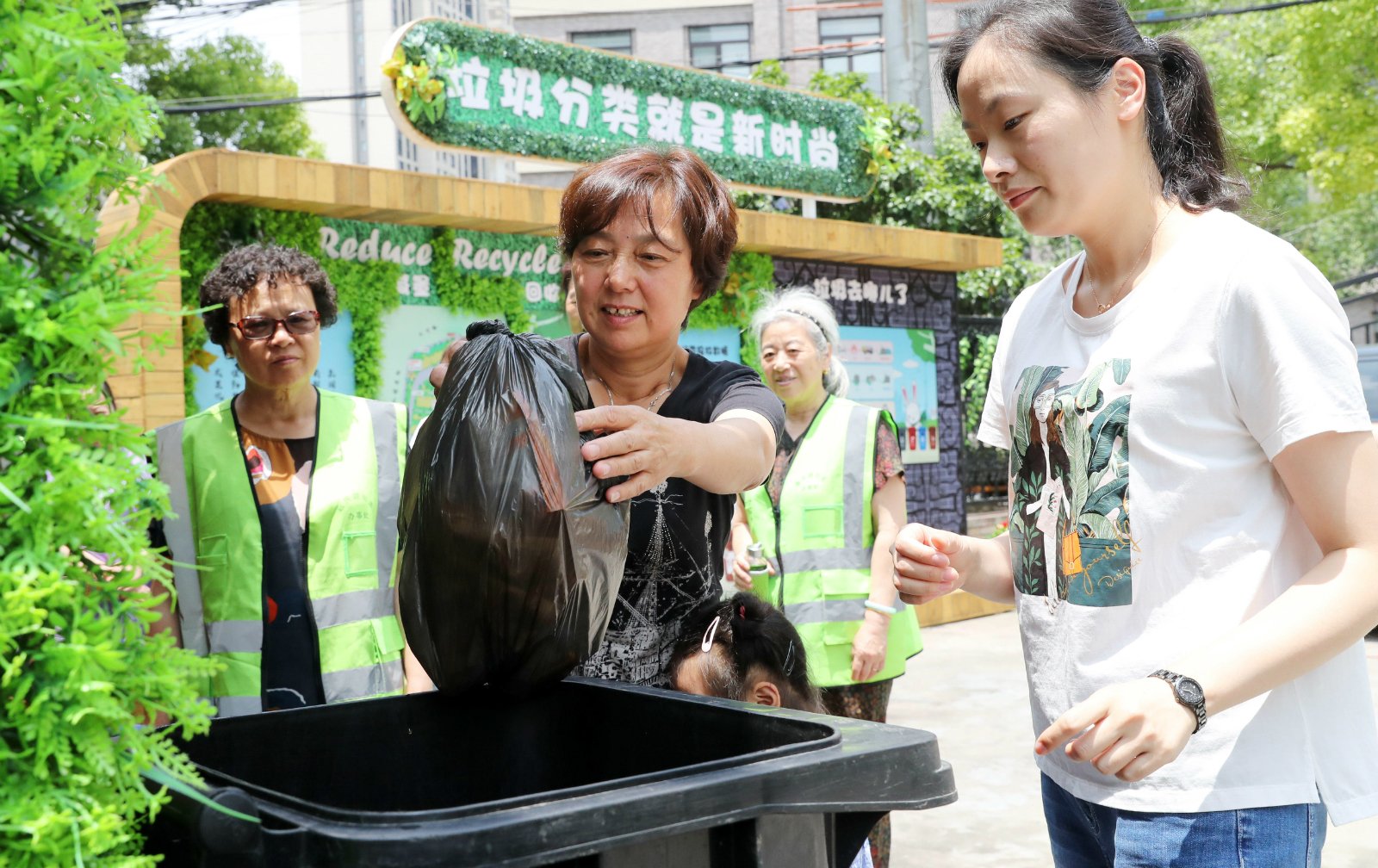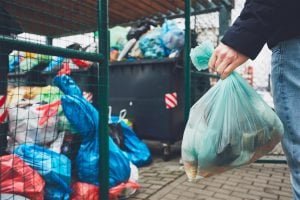The first week of July saw China’s media outlets and social media dominated by what might seem like a trivial issue. New rules came into effect in Shanghai making waste sorting compulsory for the megacity’s 20 million residents.
Waste must now be sorted into recyclables, harmful waste, wet (organic) waste and dry (other) waste. The vast majority of apartment buildings have removed waste bins from corridors and replaced them with a few centralised waste collection points, accessible only in the morning and evening.
The requirement to “gradually implement a system for collection of sorted domestic waste at specific times and places” was rolled out in one fell swoop – and to great controversy. Commenters online complained of having missed waste drop-off times, while others predicted an epidemic of fly-tipping. Jokes were made about it being easier to take the subway out of the city to get rid of your rubbish.
Numerous articles described Shanghai residents as driven crazy by changes they feel are complex, overly strict and hastily implemented. Some say the system is bound to fail, as it is the product of top-down decision-making and lacks social consensus or procedural justice. With memories of factories being shut down as part of “environmental crackdowns”, that is a view many agree with. Waste sorting is set to become compulsory in other urban areas in China, with cities of local-level and above needing systems in place by 2025. This has meant particular scrutiny for Shanghai’s approach.
Too soon, or too late?
Waste sorting policies in China have in fact been anything but rushed. After the central government identified eight trial cities in 2000, the local governments put regulations in place and some set themselves ambitious targets. Beijing, for example, aimed to have 50% of collected waste sorted in 2008, with a 30% reuse rate. Nine years later, those trials have done little good. The public does not know what happens to waste they have sorted, except that it is often mixed up again during transportation and disposal.
A key reason is that those local regulations were more suggestions than binding rules, and lacked oversight mechanisms and provision for the proper handling of sorted waste. Local governments were more interested in building expensive incinerators, as a more immediate solution to the problem than cutting waste produced and boosting recycling.
But nobody wanted incinerators in their backyard. In 2009, huge protests broke out in Guangzhou against an incinerator in nearby Panyu. Young members of the middle-class, including lawyers and media professionals, formed the core of the protest. They knew the truth behind the technological utopian promises, and that dioxins and heavy metal pollution would be a threat to their health. The Guangzhou city government took an enlightened approach and eventually abandoned the planned site – a victory for the protestors.
Guangzhou remains at risk of being encircled by landfill sites. In 2011, the city started promoting waste sorting, and set a target of having 50% of collected waste sorted with a 16% reuse rate. Waste sorting can significantly reduce the amount of waste sent to incinerators and cut the amount of moisture in that waste – meaning fewer incinerators and less harmful emissions. But the people of Guangzhou did not rise to the call and little progress has been made.
Ironically, Guangzhou continued to build incinerators after the Panyu project was cancelled. Six have been built elsewhere, away from middle-class residents and the public eye. In early June, Guangzhou announced it would build five more, as well as five new landfill projects.
Hidden pollution
Those middle-class protests in Panyu have left an environmental legacy. Some who took to the streets realised they needed an answer when people asked “so where should incinerators be built?” They saw that only by reducing the amount of waste produced, and then sorting and recycling it, could they stem the need for more incinerators. This led to the registration of new environmental NGOs, some looking at how to achieve that, others monitoring the expansion of incinerators. These groups, and a small number of other NGOs, have become a powerful civil society force promoting waste sorting and influencing the policies being rolled out.
But it remains true that the public has not heeded these environmental calls. Public environmental awareness needs to be founded on transparent pollution data, which in China is often opaque. Chinese society also lacks the capability to organise and mobilise itself, and there is no space for environmental movements to grow. Because “nimby” campaigns protect the interests of those involved and are “depoliticised”, mobilisation and growth is easier. But unless we have environmental campaigns that go beyond our own backyards, the majority of people will not see pollution as their concern – and government advocacy of waste sorting will not be enough to get them on board.
Waste sorting from above
And so for 19 years not much happened, until Shanghai’s city government decided to impose a waste-sorting system.
The new rules could be described as a tough but green system which will significantly enhance the public good. It makes its aims clear: reduce waste, reuse waste and cut pollution from waste. It is not just about getting waste out of the city. It includes requirements for each district to come up with plans for controlling waste-handling capacity, including measures to reduce and reuse waste.
And it does not merely apply to citizens. It instructs companies not to mix previously sorted waste during transportation or processing and calls for computerised management of the entire domestic waste system and separate facilities to handle and reuse the different types of waste. It also orders that only dry waste can be incinerated. Wet waste must be composted or used otherwise. It can then be used in parks or farms, returning organic material to the soil and reducing pollution from chemical fertilisers and methane emissions from landfill.
Alongside the waste-sorting system, the new rules instruct businesses and organisations – in particular online retailers, delivery firms, restaurants and hotels – to cut down on single-use products, reducing waste at the source.
There’s no question this is another environmental initiative enforced from above, and it has been criticised as “heavy-handed” and “rushed”. But unlike past initiatives it affects every household, and that participation can build environmental awareness. The residents sorting the waste become stakeholders, with a legitimate interest in overseeing government waste policy. Shanghai locals already feel entitled to criticise the new system, as it is affecting them. However, those criticisms do not yet take into account the environment or the public good.
An environmental compact
What those criticising the government don’t see is that by imposing a “radical” (actually entirely practical, given the gravity of the environmental and climate crises) policy on everyone in Shanghai, the government has taken on a great responsibility. Having made life more difficult for residents, it now needs to make sure their extra efforts do not come to nothing, and if its aims of reducing and reusing waste are achieved, the quantities of waste sent to incineration and landfill will be bought under control.
In other words, rather than the government sacrificing the interests of a minority during an environmental crackdown, on this occasion a social compact has been signed with all residents. Each party gives up a little in order to resolve waste and pollution issues. This approach arises from the nature of the waste problem. The people must do their part.
Rather than complaining of being forced to sort their waste, the public should seize the opportunity offered. The key steps to take are:
1. Ensure the government keeps waste separate during transportation and disposal, and comes up with vigorous measures to meet waste targets and so halt excessive expansion of landfill and incineration facilities.
2. Promote community self-governance. The system needs to be implemented in the most suitable style for each location and overseen in non-intrusive ways that raise community environmental awareness, so that waste sorting becomes a voluntary public action, rather than enforced behaviour.
3. Pay attention to the recycling industry and advocate for supporting policies, including the collection and processing of recyclables. The tens of thousands of workers in the informal recycling sector need to be brought within the new system, which sees collection of domestic waste and recyclables handled by government-designated firms. This will prevent large-scale job losses and the monopolisation of recycling by a small number of firms.
Just as Shanghai’s new waste-sorting rules were coming into effect, the world’s largest incineration facility was being completed 60 kilometres outside the city, in Laogang. Meanwhile residents of Yangluo, on the outskirts of Wuhan, were continuing their lonely and largely unseen protest against a new incinerator.
Thankfully, the era of waste sorting is here, and our relationship with the waste that was once hidden from us has changed. Can we seize this opportunity to create a new environmental ethics, to face up to the root causes of our problems, to accept our individual and joint responsibilities for pollution? Will we see “environmental citizens” launching new environmental movements? We will need both determination and creativity.









